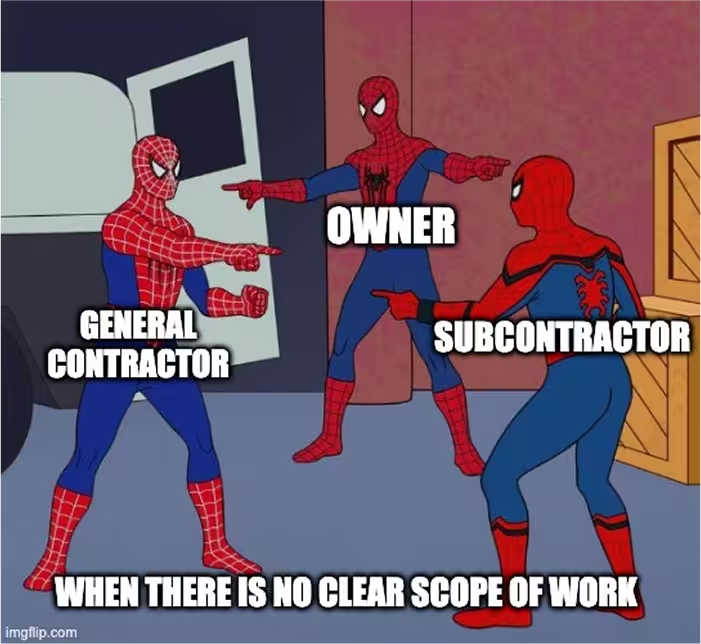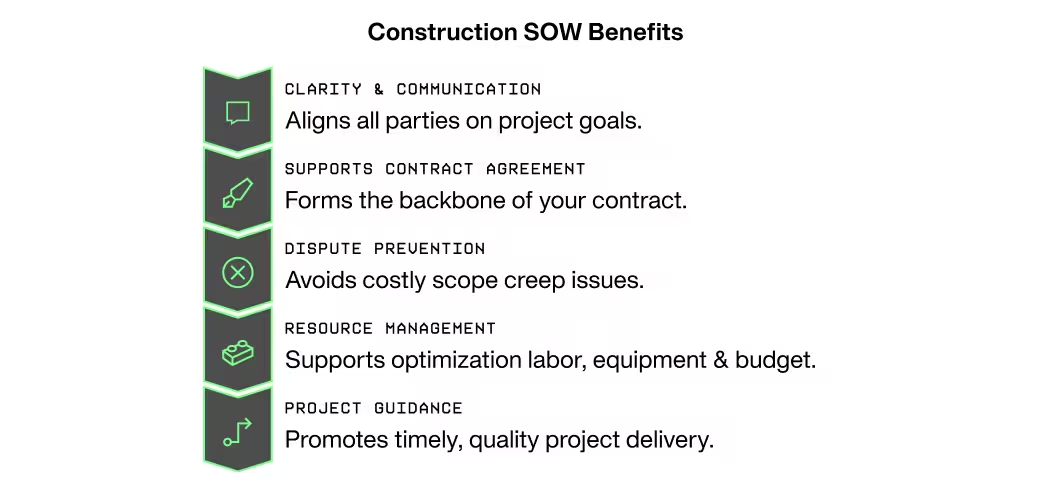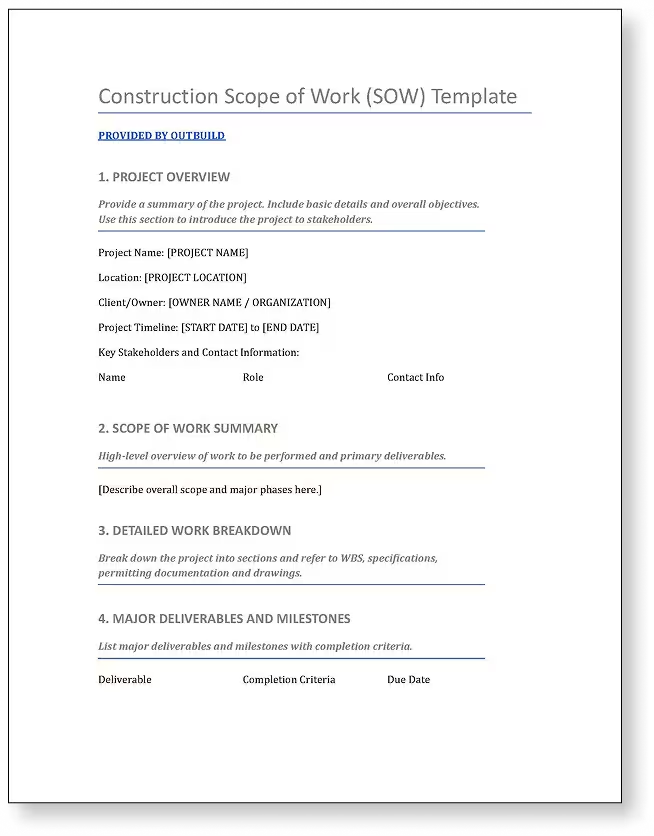Outbuild is online scheduling software to work together on connected project schedules and look-aheads, enabling everyone to move faster.
Key Takeaways
Table of contents
- What is SOW in construction?
- Understanding the Purpose of a Construction Scope of Work
- How to write a scope of work for construction
- Tips for Writing an Effective Construction Scope of Work
- Example of scope of work for construction project
- Construction Scope of Work Template
- Using Technology to Streamline the Creation of a Construction Scope of Work
- Level-Up Your Construction Scope of Work with Outbuild
A construction project can only succeed when everyone involved is working under the same plan. That’s where a construction scope of work (SOW) comes in.
A strong scope of work clearly defines the work and is the first step in bringing the vision, the drawings and specifications to life.
Without it, projects can veer off course, leading to missed deadlines, budget overruns, and frustrating disputes.

A contractor scope of work is an important document. It covers what the team builds and who participates in the project. The goal for a construction scope of work document is to ensure total clarity of the scope for all involved.
Here's an example of scope of work in construction:
The drawings show millwork in many rooms, but one sheet is unclear and doesn’t include all the details.
The construction project scope document states: “Millwork subcontractor to furnish and install all millwork shown or reasonably implied for the entire project, including items not called out on individual sheets.”
That line settles it. The millwork sub owns the scope, pricing is clear, and the team avoids RFIs and change-order fights.

Now that we are clear on a scope of work meaning in construction, let's dive into the purpose of it.
A scope of work in Construction offers:
Clarity and Communication: SOW documents helps owners, general contractors and subcontractors understand the work that needs to be done.
Agreement and Contract: A scope of work document serves as a detailed attachment to the contract, showing what the general contractor scope of work is.
Dispute Prevention: When a question comes up, the SOW answers it and helps prevent scope creep.
Resource Management: The scope document guides labor, equipment, materials, and budget planning so teams can staff correctly and control costs.
Project Guidance: A written scope of work helps a team meet project goals on time and with the right quality.

To write a solid construction scope of work, you should clearly define what you will build. Construction projects are unique and each scope of work in construction project management looks different.
However, there are some key components that every construction scope of work should include:
Key Components of a Construction Scope of Work
Project Overview: A short, 10,000-foot level summary in a document that outlines what will be delivered.
Deliverables: A breakdown of what must be finished at each phase so the team knows what “complete” means for the construction project scope of work.
Tasks and Activities: This includes high level deliverables such as Coordinate FFE with Owner.
Milestones and Timeline: A SOW in construction does not include a full schedule but it should highlight major dates and checkpoints that track progress, such as mobilization, and substantial completion.
For example, a note about completing work before the academic year begins might be included on a higher education project scope of work.
Responsibilities: Identify who is involved in the project. This includes the general contractor, trade partners, suppliers, and the owner. This is not a granular list.
An example of responsibilities listed within a SOW would be: Contractor will be responsible for coordinating the project with the City of Phoenix.
Requirements: The scope of work for construction should lay out requirements of getting the project done.
Let’s consider an example that might be included in a renovation scope of work document: Before starting the redesign of the main HVAC system, the contractor will inspect the current setup. The contractor is to figure out which parts are still in good condition and can be reused, and which ones need to be replaced to make the new system work efficiently.

Exclusions: A list of what is not included in the scope of work for construction to avoid assumptions and prevent disputes later on.
Budget and Payment Terms: Details about how the work will be billed, payment schedules, and any documents required for payment, like lien waivers or progress reports.
Project Assumptions and Constraints
Any special conditions that affect the work include:
- Limits on site access
- Restricted work hours
- Owner-supplied materials
- Environmental factors
A work scope is a tool that every contractor needs to tailor to its company’s needs. There are methods that a contractor can use to make sure their work is effective and gets the job done.
Use Clear, Concise Language: Avoid jargon - keep sentences short so everyone reads and follows the construction project scope of work without confusion.

Refer to important documents: The scope of a construction project should point to other important documents instead of repeating them. For example, rather than rewriting the entire schedule in the SOW, simply reference it. This keeps the scope focused and avoids conflicting information later.
Get Clear on Roles and Responsibilities: Spell out who does what: GC, subs, designers, suppliers, to avoid gaps and overlaps.
Express Payment Terms: Explain billing cycles, documents required (lien waivers, certified payroll, photos), and payment timing.
Define Change Order Procedures: Show how to request, price, approve, and track changes. A clean process keeps the work scope stable and fair.
Collaborate with Stakeholders: Get input from owners, designers, and trade partners so the construction company scope of work is complete and practical.
Click here for a construction project scope of work example. Or, click here for another sample scope of work for construction project.
We have also included a construction management scope of work example that is shown within this owner's representative agreement.
The above are just some examples of scope of work for construction, keep in mind each project is different and each construction project scope varies.
There are many ways to use technology in construction SOW creation. These methods save time, improve accuracy, or both. Here are some tips:
Project management software: Plan phases, assign roles, schedule tasks, and track budgets to inform your scope of work.
BIM tools: Visuals make the scope of work in construction easier to understand, especially for non-design stakeholders. They also help refine specs and coordination.
Cloud storage: Keep the scope of work document accessible to the right people from anywhere. Easier access means better accountability and fewer surprises.
Scheduling is a big driver of staying within construction scope. With Outbuild’s construction scheduling and planning software, teams can review analytics, adjust plans, and choose efficient paths at each milestone.
Having your project deliverables in a connected Gantt chart helps you maintain a clear and realistic scope of work. This connects the field and the office and supports a successful project.
Now that you understand the scope of work definition in construction, book a demo or start your 14-day free trial today to ensure your project stays on track. Even the best scope of work can fall apart without the right scheduling tools.
There are many ways to use technology in construction SOW creation. These methods save time, improve accuracy, or both. Here are some tips:
Project management software: Plan phases, assign roles, schedule tasks, and track budgets to inform your scope of work.
BIM tools: Visuals make the scope of work in construction easier to understand, especially for non-design stakeholders. They also help refine specs and coordination.
Cloud storage: Keep the scope of work document accessible to the right people from anywhere. Easier access means better accountability and fewer surprises.
Scheduling is a big driver of staying within construction scope. With Outbuild’s construction scheduling and planning software, teams can review analytics, adjust plans, and choose efficient paths at each milestone.
Having your project deliverables in a connected Gantt chart helps you maintain a clear and realistic scope of work. This connects the field and the office and supports a successful project.
Now that you understand the scope of work definition in construction, book a demo or start your 14-day free trial today to ensure your project stays on track. Even the best scope of work can fall apart without the right scheduling tools.
Frequently Asked Questions
Use your standard template and tailor by trade. Include labor type, work hours, trade standards, submittals, permits, testing, safety, and closeout. Keep only what applies to that trade and what the project requires.
Set a clear change order process in your construction SOW. Require written approvals before work starts. Track impacts to cost and time.
Use tight deliverables, defined exclusions, and a quick change workflow. Review drawings and RFIs often so the scope of work for construction stays accurate.
A good scope sheet outlines the job from general details to trade-specific tasks. Start with basics like labor type and work hours, then add company standards, permits, inspections, and scope-specific tasks such as equipment installation. Customize for each trade—a one-day window film installer won’t need weekly meetings, while a metal sub may need hot-work permits.
To create a construction scope of work, start with a template to ensure consistency. Add project details step by step—overview, deliverables, timeline, roles, and quality standards. Review it with all stakeholders, make adjustments, and get final signatures. This process creates a clear, enforceable document that protects everyone involved.
Related Articles
Ready to see Outbuild?
Join hundreds of contractors from 10+ countries that are saving money by scheduling better









